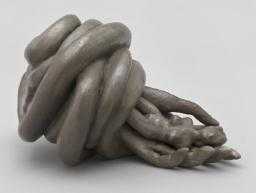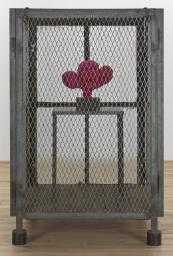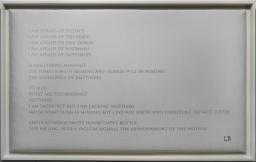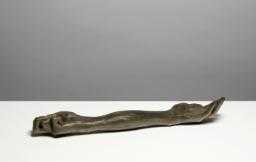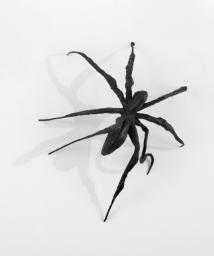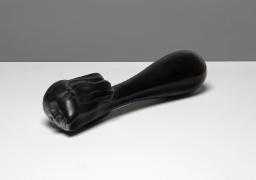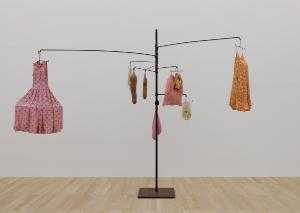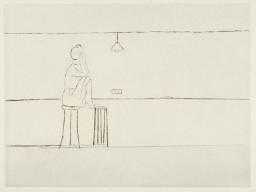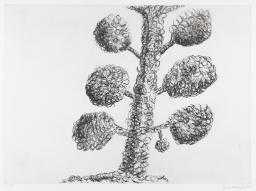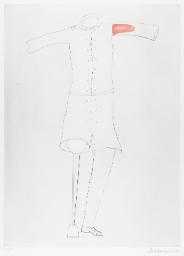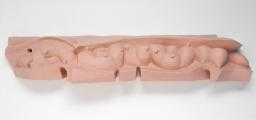
Not on display
- Artist
- Louise Bourgeois 1911–2010
- Medium
- Fabric, hanging piece
- Dimensions
- Object: 2032 × 685 × 711 mm, 15 kg
- Collection
- ARTIST ROOMS
Tate and National Galleries of Scotland. Lent by Artist Rooms Foundation 2013
On long term loan - Reference
- AL00344
Summary
Couple I is a hanging sculpture comprised of two stuffed textile pieces sewn together, depicting two headless, hanging figures in an embrace. Bourgeois used fabric, lace, socks, nylon tights and one of her own blouses to create the sculpture. One figure is made of fabric associated with more masculine clothing; blue pinstriped shirt and black flannel. The other figure has more feminine attributes including a lace collar and stuffed pair of black nylon tights. The arms and legs of the masculine figure are sewn together around a metal meat hook, which is used to hang the work on wire from the ceiling. The feminine figure sits in the looped torso, with nylon legs hanging down at either side and a single limb reaching around the torso of the other fabric body. Couple I formed part of an installation displayed in the bell tower of St Pancras Church in London for the exhibition ‘The Visible and the Invisible’ in 1996. Bourgeois made four figurative stuffed fabric sculptures for this piece: Single I 1996, Single II 1996 (Tate AL00229), Couple I 1996 and Couple II 1996. All of the sculptures were hung from the bell tower except Couple II, which was displayed nearby on the floor.
In this work Bourgeois addresses the complex nature of relationships. The masculine and feminine figures of Couple I are locked in an embrace that could be read as both supportive and strained. The masculine figure both constricts and holds the feminine figure. Likewise, she encircles him with a caring arm whilst straddling and weighing down his hanging body. The curator Lucy Askew has argued that, ‘hanging from a meat hook, these archetypes lack the capacity to move or part and are bound in an embrace that suggests more anguish than pleasure.’ (Askew and d’Offay 2013, p.83.) Yet their proximity and dependency could also be indicative of an intense emotional attachment as well as the physical act of having sex. Indeed the suspension of Couple I suggests the destabilizing feeling of falling in love. On the notion of the hanging figure, a recurring conceit in Bourgeois’s practice, the artist has said: ‘Horizontality is a desire to give up, to sleep. Verticality is an attempt to escape. Hanging and floating are states of ambivalence.’ (Quoted in Askew and d’Offay 2013, p.48.)
As the figures float in space, they almost form an infinity symbol suggestive of the inexorable cycle of a relationship. Yet the ‘timeless’ nature of the work – we are unsure of the age of the headless figures – might be read as the artist’s reflection on her own past relationships. This correlates with curator Marie-Laure Bernadac’s argument that Bourgeois’s intense focus on the nature of sexual relationships between men and women in her later career ‘can be seen to derive from the return of repressed memories.’ (Quoted in Morris 2007, p.90.)
Further reading
Mignon Nixon, Fantastic Reality: Louise Bourgeois and a Story of Modern Art, Cambridge, Massachusetts, and London 2005.
Frances Morris (ed.), Louise Bourgeois, exhibition catalogue, Tate Modern, London 2007, pp.90–2, reproduced p.92.
Lucy Askew and Anthony d’Offay, Louise Bourgeois: A Woman Without Secrets, exhibition catalogue, National Galleries of Scotland, Edinburgh 2013, p.83, reproduced pp.25, 47.
Allan Madden
The University of Edinburgh
January 2015
The University of Edinburgh is a research partner of ARTIST ROOMS.
Does this text contain inaccurate information or language that you feel we should improve or change? We would like to hear from you.
Display caption
The couple represented here appear to merge into each other. As in many of Bourgeois’s works, male and female are combined in an ambiguous arrangement of body parts. For Bourgeois, hanging indicates a state of uncertainty. ‘Horizontality is a desire to give up, to sleep’, she said. ‘Verticality is an attempt to escape. Hanging and floating are states of ambivalence.’
Gallery label, October 2016
Does this text contain inaccurate information or language that you feel we should improve or change? We would like to hear from you.
You might like
-
Louise Bourgeois Nature Study
1986 -
Louise Bourgeois Single II
1996 -
Louise Bourgeois Cell XIV (Portrait)
2000 -
Louise Bourgeois I Am Afraid
2009 -
Louise Bourgeois Give or Take
2002 -
Louise Bourgeois Spider I
1995 -
Louise Bourgeois Spider
1994 -
Louise Bourgeois Fallen Woman
1981 -
Louise Bourgeois Untitled
1996 -
Louise Bourgeois Ode à Ma Mère
1995 -
Louise Bourgeois Empty Nest
1994 -
Louise Bourgeois Tree
1998 -
Louise Bourgeois Amputee with Peg Leg
1998 -
Louise Bourgeois Mamelles
1991, cast 2001 -
Louise Bourgeois Maman
1999

